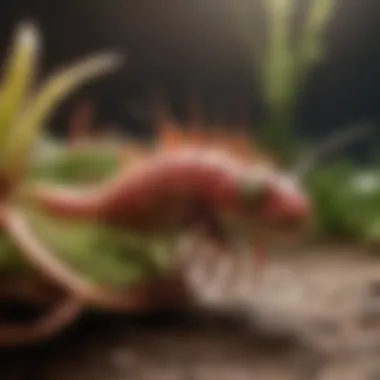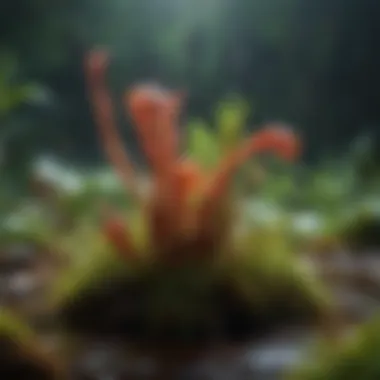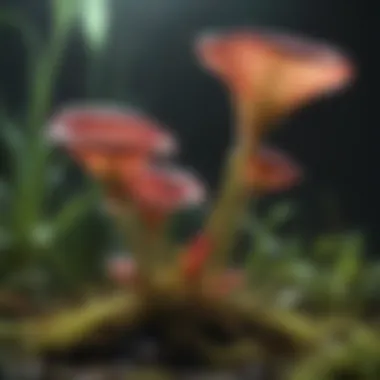Discovering the World of Carnivorous Plant Websites


Nature Topic Overview
Carnivorous plants captivate imaginations with their unique adaptations and intriguing mechanisms for survival. These remarkable organisms have evolved to lure, trap, and digest unsuspecting prey, primarily insects. And they thrive in nutrient-poor environments where their ability to supplement their diet is essential. Within this article, we will explore a wealth of resources available on various carnivorous plant websites and how they cater to children, parents, and educators alike.
Websites dedicated to these fascinating plants enrich our understanding of their biology and habitats. For children aged 5 to 12, these platforms provide engaging information that encourages curiosity about nature. Parents and teachers can find valuable resources for educational purposes, enhancing learning in a fun way. This exploration showcases the importance of these websites in fostering a connection with nature, as well as providing unique educational experiences.
Fun Facts and Trivia
Engaging young learners with fun facts can spark their interest in carnivorous plants. Below are some interesting tidbits:
- Famous Species: The Venus flytrap is perhaps the most well-known carnivorous plant, with its jaw-like leaves.
- Unique Traps: The Nepenthes, or pitcher plant, has a special pitfall trap, resembling a jug that collects water.
- Speedy Actions: The leaf traps of the Venus flytrap snap shut in less than a second when an unsuspecting insect touches its sensory hairs.
Interactive elements on websites can include colorful diagrams and animations that portray how these traps function. Additionally, some websites feature videos of these plants in action, captivating the attention of young viewers and enhancing their learning experience.
Wildlife Explorations
Various species of plants inhabit specific ecosystems, making learning about them even more interesting. Here are some key species related to carnivorous plants:
- Drosera: Also known as sundews, these plants capture and digest insects using their sticky glandular leaves.
- Sarracenia: Commonly referred to as North American pitcher plants, they have tall, tubular structures that trap and digest prey.
Children can learn about the habitats these plants flourish in, such as wetlands and bogs. Exciting animal interactions might also be explored. For example, the relationship between insects and these plants emphasizes nature’s balance. Interactive quizzes and puzzles can test children’s knowledge and allow them to apply newfound information.
Environmental Awareness
Understanding the importance of conservation and sustainability forms a crucial part of learning about carnivorous plants. Many species are at risk due to habitat loss and environmental changes. Children can be encouraged to take action, even in small ways:
- Plant Care: Learn to care for a carnivorous plant at home. Getting involved in plant care fosters responsibility and awareness.
- Nature Walks: Go on outdoor explorations to observe local flora and fauna. Discuss human impact on these ecosystems and how children can promote their preservation.
By engaging in activities that support environmental awareness, children build a sense of responsibility towards nature and its conservation.
DIY Nature Activities
Hands-on activities inspire creativity and foster a deeper connection with nature. Here are some engaging activities:
- Creating Your Own Terrarium: Gather materials such as glass containers, soil, and small carnivorous plants. Follow simple steps to create a mini-ecosystem at home.
- Crafting Plant Models: Use art supplies to model various carnivorous plants. This can assist in visualizing their unique features and function.
- Outdoor Exploration: Organize nature scavenger hunts where children search for different plants and insects. This activity encourages them to observe and appreciate their surroundings.
These DIY activities make learning enjoyable and memorable, encouraging children to apply knowledge gained from online resources in real-life scenarios.
Preface to Carnivorous Plants
Carnivorous plants are fascinating members of the botanical world, captivating the attention of children and adults alike. They possess unique mechanisms that allow them to trap and digest prey, primarily insects. This article seeks to highlight their importance and the value they bring to ecosystems.
Exploring the realm of carnivorous plants offers benefits beyond understanding their biology. Such studies can foster curiosity in young minds and help them connect with nature. Moreover, this subject sheds light on nutrient cycling in ecosystems where these plants thrive. Understanding carnivorous plants is essential in promoting environmental education and appreciation for biodiversity.
Defining Carnivorous Plants
Carnivorous plants are species that have evolved to obtain nutrients through trapping and digesting other organisms. The most common traps include:
- Pitfall traps: Found in plants like the pitcher plant, where liquid fills a deep cavity, ensnaring prey.
- Snap traps: Such as those seen in Venus flytraps, which are quick to close on unsuspecting insects.
- Suction traps: Utilized by plants like bladderworts, where a rapidly opening trap sucks in prey.
These adaptations allow carnivorous plants to thrive in nutrient-poor environments. Water, light, and the right soil conditions are crucial for their growth, which makes understanding their needs important for cultivation.
Why Study Carnivorous Plants?
Studying carnivorous plants is significant for several reasons. First, they illustrate the vast diversity of life forms found on Earth. These plants showcase evolution at work, where adaptations solve survival challenges.


Second, they spark interest in ecology and conservation. Learning about carnivorous plants helps awareness about their habitats and the species they depend on. This knowledge can encourage protective measures needed to preserve these unique ecosystems.
Lastly, incorporating carnivorous plants in education can enhance critical thinking and scientific inquiry. Children can engage with hands-on activities, such as observing plant behavior, which nurtures a love for science and nature. By understanding these plants, we not only enrich our knowledge but also promote sustainability.
"Exploring the unique world of carnivorous plants opens doors to deeper ecological awareness."
In summary, diving into the study of carnivorous plants enriches our understanding of biodiversity and evolution while encouraging a deeper connection between children and nature.
Overview of Carnivorous Plant Websites
Carnivorous plant websites serve as crucial resources for anyone interested in these fascinating organisms. The wide variety of sites reflects the growing interest in the unique adaptations of plants that derive nutrients from trapping and consuming animals. Understanding the structure and function of these websites becomes salient for users seeking both knowledge and community.
Various carnivorous plant websites differ significantly in their focus and features. Some are dedicated to research and education, while others emphasize cultivation or hobbyist discussions. By exploring these varied offerings, users can enhance their understanding of carnivorous plants and how to care for them.
Types of Websites Dedicated to Carnivorous Plants
A diverse range of websites cater to the interests of carnivorous plant enthusiasts. Here are some common types:
- Educational Institutions: Websites like those from universities often provide in-depth research articles and papers on the biology and ecology of carnivorous plants. They may also feature conservation initiatives which are vital.
- Hobbyist Forums: These platforms, including Reddit threads or specific forums, create spaces where amateurs and experts share cultivation tips, trade plants, and discuss related experiences.
- Retail Sites: Businesses that specialize in selling carnivorous plants usually have sections dedicated to plant care guides and resources. For example, companies such as The Carnivorous Plant Nursery provide not only products but also extensive care information.
- Non-Profit Organizations: Websites focused on conservation offer educational resources aimed at promoting awareness about the need to protect natural habitats that host these plants. They may conduct workshops and community events.
By utilizing the resources from these varied types of websites, users can deepen their knowledge about carnivorous plants while interacting with a larger community that shares similar interests.
The Role of Educational Content
Educational content is the cornerstone of carnivorous plant websites. This type of information not only engages users but also provides them with credible knowledge. It can take many forms:
- How-to Articles: These practical guides help beginners understand how to cultivate carnivorous plants correctly. They often cover topics like soil requirements, watering techniques, and pest management.
- Scientific Research: Publications and findings from researchers contribute to a comprehensive understanding of these plants. Users can learn about adaptations, biodiversity, and ecosystems where these plants thrive.
- Conservation Efforts: Websites often highlight the importance of protecting these unique plants and their natural environments. They may provide details on threats to their habitats and ways users can contribute to conservation.
Educational resources also encourage critical thinking, prompting discussions and questions that further enhance learning. With so much information available, users are empowered to take action in cultivating their interest in nature and possibly advocating for conservation efforts.
"Knowledge is the first step towards preservation. Understanding carnivorous plants deepens our respect for biodiversity."
Overall, the educational content available on carnivorous plant websites serves as a vital resource for all ages. It equips users with information that is essential for responsible stewardship of the natural world.
Educational Resources on Carnivorous Plant Websites
Educational resources found on carnivorous plant websites play a vital role in introducing children and other enthusiasts to the fascinating world of these unique plants. Such resources provide various avenues for learning, making the experience interactive and enjoyable. Websites dedicated to carnivorous plants often feature a blend of articles, videos, and interactive tools that cater to different learning styles. This section focuses on the specific elements of educational resources, their numerous benefits, and considerations that should be kept in mind while exploring them.
Articles and Guides
Articles and guides serve as foundational resources for anyone interested in carnivorous plants. These texts usually cover a wide range of topics including species identification, care instructions, and habitat information. Visitors can expect to find detailed write-ups addressing common questions, like how to keep these plants healthy or where to find them in nature.
Some resources might include:
- Species profiles detailing specific plants like Venus flytraps or Sundews.
- Care guides that help users learn about feeding, watering, and general plant maintenance.
- Conservation information on the importance of preserving these plants and their habitats.
Guides written for children often use simple language and engaging visuals, enhancing comprehension and retention. They create an atmosphere of curiosity and excitement while respecting the intelligence of young learners.
Video Content and Documentaries
Moving onto another critical aspect, video content and documentaries offer visual and auditory learning opportunities. Videos can capture attention effectively, making complex information more digestible. Many websites host tutorials on how to care for these plants, with step-by-step visuals demonstrating various methods. For example, a video explaining how to transplant a pitcher plant can show the process, making it clearer for viewers to understand.
Additionally, documentaries provide fascinating insights into the ecosystems where these plants thrive. They often include interviews with botanists and conservationists, educating viewers about the biodiversity and unique adaptations of carnivorous plants. Watching these films can inspire a deeper connection with nature and raise awareness about the environmental challenges facing these species.
Interactive Learning Tools
Interactive learning tools are equally important. Activities like quizzes, games, and virtual tours engage children, encouraging hands-on exploration of carnivorous plants. These tools not only reinforce knowledge but also help develop problem-solving skills.


Some examples include:
- Interactive quizzes that test knowledge on plant care and species facts.
- Virtual greenhouse tours that allow users to explore different environments where carnivorous plants grow.
- Games that challenge players to identify plants based on clues or prepare a healthy habitat for them.
By integrating fun with learning, interactive tools foster a genuine interest among kids, nurturing a future generation that is conscious about nature and its preservation.
"The combination of articles, videos, and interactive tools creates a well-rounded learning experience that is both educational and engaging."
In summary, educational resources on carnivorous plant websites offer a rich tapestry of information and experiences. By providing varied forms of content, they make the learning journey appealing and accessible. Whether through reading, watching, or interacting, users can expect to deepen their knowledge about these fascinating organisms.
Community Engagement in Online Spaces
Community engagement plays a significant role in the realm of carnivorous plant websites. This engagement provides a platform where enthusiasts can connect, share knowledge, and inspire each other. It fosters a sense of belonging among members, allowing participants to exchange information about these fascinating plants. Moreover, engaging with a community increases the collective understanding of carnivorous plants.
The benefits of community engagement can be seen in many ways. First, it encourages collaboration among users. When individuals share their experiences or findings, the community grows richer in content and knowledge. Members can debate ideas, offer insights, and expand on each other's thoughts.
In addition to sharing knowledge, community spaces also provide a support system. Newcomers to the topic may have questions or need guidance. In forums or on social media, they can find answers quickly. This accessibility is vital in understanding how to care for, grow, and appreciate carnivorous plants.
Furthermore, an engaged community can raise awareness about conservation efforts. Carnivorous plants have unique needs and some species are endangered. By discussing these issues online, community members can mobilize efforts to protect these species, spreading awareness broadly.
Ultimately, community engagement fosters a love for nature and its intricacies. When children and adults connect over shared interests, they are more likely to develop a lasting appreciation for the environment.
Forums and Discussion Boards
Forums and discussion boards are vital components of online communities centered around carnivorous plants. They allow users to post questions, share experiences, and discuss topics relevant to plant care. One of the primary benefits of forums is that they create an organized space where information is categorized. Users can easily navigate discussions based on specific interests or needs. Examples include:
- Growing techniques for specific species.
- Pest control methods.
- Propagation tips and tricks.
Additionally, forums provide an opportunity for diverse perspectives. While one member may have extensive experience with a particular plant, another may provide a fresh viewpoint. This diversity aids in deeper understanding and offers solutions that one person alone may not consider.
Social Media Connections
Social media platforms such as Facebook and Instagram have become essential tools for the carnivorous plant community. These platforms allow for rapid sharing of images and experiences. Users can post pictures of their plants, ask questions in real-time, or join groups dedicated to specific species.
In groups on Facebook, for instance, members can find specific communities focused on topics like plant care tips, species identification, or even trading plants. This interactivity enhances user experiences and strengthens connections.
Moreover, social media offers a visual aspect that forums lack. Enthusiasts can showcase their plants, leading to inspiration for nurturing and growing techniques.
Prominent Carnivorous Plant Websites
The exploration of carnivorous plant websites provides essential insights into these fascinating organisms. As we navigate this digital realm, it is important to recognize the myriad resources available online. Prominent carnivorous plant websites serve as valuable hubs for enthusiasts, educators, and curious learners alike. These platforms often offer unique insights into cultivation, conservation, and the biology of various species.
Website Reviews
When discussing notable websites, it is crucial to assess their content and user interface. Websites like Carnivorous Plant Society, Sarracenia.com, and Eat The Weeds provide extensive information on care techniques, species identification, and growth tips. A detailed review of these websites helps users identify which resources align best with their needs.
- Carnivorous Plant Society often features articles authored by experts in botany and horticulture, ensuring readers gain reliable insights.
- Sarracenia.com presents a range of photographs that aid in identifying species and understanding different growth stages.
- Eat The Weeds combines information about carnivorous plants with practical advice on incorporating them in home gardening.
Such reviews highlight strengths and weaknesses in websites. For instance, the visual content on Sarracenia.com enhances understanding, while lengthy articles may overwhelm younger users or new enthusiasts.
User Experience Assessment
The user experience on these websites significantly affects learning and engagement. A well-designed website promotes easy navigation and encourages return visits. An effective layout features:
- Clear menus that guide users to desired topics.
- Engaging visuals that showcase the beauty of carnivorous plants.
- Accessible language that aids understanding for all ages.
User feedback is instrumental in evaluating the overall experience. Many websites incorporate forums or feedback sections, allowing users to voice their opinions. This feedback mechanism helps site owners improve functionality and content based on user interactions. Websites like Reddit have active communities discussing the latest in plant care and arrangements.
Engagement metrics such as page loading time and mobile compatibility also factor into user experience. A website that loads quickly and operates seamlessly on mobile devices attracts a broader audience. In summary, reviewing website content and assessing user experience can empower users to navigate this vibrant online ecosystem effectively.
Exploring websites focused on carnivorous plants offers several advantages for children, parents, and educators. These platforms serve as windows into a fascinating world that combines education with nature. The benefits include enhancing ecological knowledge, promoting conservation efforts, and developing a genuine appreciation for plant life.
Enhancing Knowledge about Ecosystems


Carnivorous plants are unique organisms that play specific roles within their ecosystems. When users engage with dedicated websites, they can learn about the diverse habitats where these plants thrive. Information can include how they catch prey and how this impacts the food chain. Websites often provide detailed descriptions of various species, including the Venus flytrap and the pitcher plant. Understanding the interactions between these plants and their environment fosters a deeper awareness of biodiversity.
Learning about ecosystems through this lens allows young audiences to grasp concepts such as food webs and ecological balance. By presenting complex topics in accessible formats, these websites cater effectively to a younger demographic.
Encouraging Conservation Awareness
Carnivorous plant websites often emphasize the importance of conservation. Many of these species are endangered or threatened due to habitat loss and environmental changes. Websites can showcase conservation projects or highlight ongoing initiatives aimed at protecting these plants. Education about these challenges can inspire children and families to take action.
Conservation tips might include simple practices such as:
- Reducing plastic use
- Supporting local conservation groups
- Participating in community garden projects
This understanding instills a sense of responsibility towards nature and encourages proactive behaviors in young learners.
Fostering a Love for Nature
Cultivating a love for nature leads to lifelong benefits. Children may develop interests in botany, ecology, or environmental science. Building connections with the natural world helps in nurturing environmentally conscious individuals.
"By fostering a connection with nature, we create a generation that appreciates and protects our planet."
In summary, the exploration of carnivorous plant websites extends beyond simple enjoyment. It enriches users' understanding of ecosystems, promotes conservation, and inspires love for nature, fostering a better future for both people and plants.
Safety and Reliability Considerations
When navigating websites about carnivorous plants, understanding the safety and reliability of information is crucial. Given the interests of children, parents, and educators, it is important to ensure that the content found online is accurate and trustworthy. This increases safety regarding misinformation and enhances learning experiences. By discerning between credible sources and unreliable ones, users can form a solid foundation of knowledge about these fascinating plants.
Identifying Credible Sources
Characteristics of credible sources include:
- Authorship: Articles should be written by experts in botany or ecology.
- References: Reliable websites often cite their sources or provide links to further reading.
- Reviews: Consider user reviews or testimonials to gauge the overall reliability of the site.
- Contact Information: Credible websites usually provide contact information, making it easier to verify their legitimacy.
In addition, established sites like en.wikipedia.org and britannica.com can serve as excellent starting points for understanding the broader context of carnivorous plants.
Assessing Accuracy of Information
Once a source is deemed credible, the next step is assessing the accuracy of the information. This involves checking for factual consistency and clarity. Look for specific details related to carnivorous plants, such as their habitats, feeding mechanisms, and conservation status. Reliable articles should present a balanced view, avoiding overgeneralizations.
To ensure accuracy, consider these questions:
- Does the content contain current data? Scientific findings can change over time.
- Are there contradictory statements within the article?
- Does the site explain complex terms in a way that is accessible for children?
By carefully evaluating both the credibility and the accuracy of online content, users will be better positioned to enjoy the rich world of carnivorous plants safely. This attention to detail not only enhances the educational benefits but also nurtures a deeper appreciation for nature.
Culmination
The conclusion of our exploration into carnivorous plant websites is a significant aspect of this article. It brings together the insights gained and highlights the importance of these platforms in the larger context of education, conservation, and community engagement. Understanding this topic is essential for anyone interested in developing a deeper connection with nature, especially for children and their guardians.
Recap of Key Findings
In summary, we have covered a variety of topics that underline the value of carnivorous plant websites. Key findings include the following points:
- Diverse Resources: These websites offer an array of educational materials including articles, videos, and interactive tools that pique interest and inspire learning.
- Community Engagement: Forums and social media channels create spaces for enthusiasts to share experiences and knowledge, fostering a robust community.
- Safety Awareness: Recognizing credible sources and assessing the reliability of information serve as necessary skills for users, particularly for younger audiences.
Each element contributes to a comprehensive understanding of carnivorous plants, making these websites vital for nurturing curiosity and informing conservation efforts.
Encouraging Exploration
Encouraging exploration of carnivorous plant websites is crucial. These engaging digital platforms provide a unique opportunity for interaction with plant species that many find fascinating.
- Promoting Curiosity: Exposure to unusual plants stimulates questioning and inquiry, motivating young minds to learn more about the natural world.
- Interactive Learning: Through games and quizzes, children can engage with content in a fun way, reinforcing their knowledge through practice.
- Awareness and Conservation: Learning about these plants can also inspire action towards conservation, as young learners become conscious of environmental issues.
Engaging with these resources can lead to a lifelong interest in nature, making exploration not only beneficial but essential in today’s digital age. Every venture into these websites is a step toward greater awareness and respect for the ecological balance of our planet.







